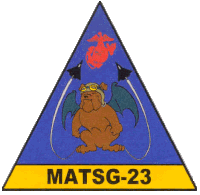MAG-23
| Marine Aviation Training Support Group 23 | |
|---|---|

MATSG-23 insignia
|
|
| Active | March 1, 1942 – November 1, 1945 January 15, 1982 - present |
| Country | United States |
| Branch | United States Marine Corps |
| Role | Training |
| Part of | Marine Corps Training Command |
| Garrison/HQ | Naval Air Station Pensacola |
| Nickname(s) | "The Lifeblood of Marine Aviation" |
| Engagements |
World War II * Battle of Guadalcanal |
| Commanders | |
| Current commander |
Colonel Donald C. Chipman |
Marine Aviation Training Support Group 23 (MATSG-23) is a United States Marine Corps aviation training group originally established during World War II as Marine Aircraft Group 23 (MAG-23). Squadrons from MAG-23, augmented by Navy and Army flying units formed the Cactus Air Force during the Battle of Guadalcanal. Since then it has evolved into the first Aviation Logistics focused Colonel level command, and serves as a functional training advocate for all USMC Aviation Logistics entry-level training. The instructors and support staff of MATSG-23 are responsible for training thousands of Marines per year in the disciplines required to enable the expeditionary aviation required to support the Marine Air Ground Task Force.
MATSG-23's mission is to serve as the functional training advocate for all USMC Aviation Logistics entry-level training, to include initial accession, primary MOS, Aircraft Maintenance Officer, Aviation Ordnance Officer Career Progression Schools and Air Traffic Control Officer Course. Additionally, as directed by Training Command, MATSG-23 provides administrative and logistical support to regionally located units in order to prepare Marines for service in the Fleet Marine Force.
Marine Air Group 23 was commissioned at Marine Corps Air Station Ewa, Hawaii, as part of the 2nd Marine Aircraft Wing on March 1, 1942. The group became the first Marine aviation group to meet the Japanese in the South Pacific. They formed the forward echelon of the 1st Marine Aircraft Wing (1st MAW) during the Battle of Guadalcanal and landed its first units at Henderson Field, Guadalcanal on August 20, 1942 when VMF-223 and VMSB-231 were flown off the USS Long Island (CVE-1). Ten days later the group's rear echelon, composed of VMF-224 and VMSB-232, joined the forward echelon at Henderson Field. MAG-23, augmented by Army and Navy land based air under the operational control of 1st MAW, furnished air support to the 1st Marine Division and Army ground forces in the struggle for Guadalcanal. The Group composed of only four Marine squadrons, detachments from six Navy carrier squadrons (VS-5, VB-6, VF-5, VS-71, VT-8 and VS-3), and the 67th Army Pursuit Squadron. This heterogeneous group shot down 244 enemy planes in four weeks. Navy pilots accounted 44, Army flyers, using P-400s shot down eight. The remaining 192 were credited to Marines. Though MAG-23 suffered casualties as well (22 Marine pilots killed in action, three by enemy naval gunfire), their actions were vital in the legendary Marine victory at Guadalcanal. From Guadalcanal, MAG-23 was transferred to the Naval Air Station San Diego where it served as a part of Marine Air, West Coast from November 18, 1942 until January 9, 1943. The group was then transferred to Marine Corps Air Station El Toro until September 1943. On September 19, 1943, the group again landed at MCAS Ewa and remained there as part of Marine Air Hawaiian Area until May 1944. On May 8, 1944, the group transferred to Midway Atoll where it remained until the war ended. After the war, MAG-23 returned to the West Coast and was decommissioned on November 1, 1945.
...
Wikipedia
